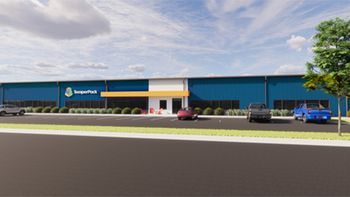
- Pharmaceutical Commerce - October 2022
- Volume 17
- Issue 5
Cold Chain Tech Continues to Evolve
The pandemic, which stressed all participants in the pharma cold chain, has not stopped innovation in industry practices, as exploration of the main drivers shows
Service providers and equipment vendors supporting the global pharmaceutical cold chain market in the past couple years have done double duty: not only did they have to drastically step up their supply of containers, refrigerants, and transportation services, but they also developed a raft of new configurations and service capabilities.
Those new capabilities are now providing benefits to the “rest of” the pharma cold chain—the biologic and temperature-sensitive formulations that the pharma industry is increasingly bringing to market. Cases in point:
- Pallet containerization for air freight. Envirotainer brought out the Releye container, designed to convey up to four US or five European-style pallets with a lower weight and smaller carbon footprint. The just-introduced va-Q-one 300P, from Va-Q-Tec, is designed for single-use shipments to countries where the return of a lease air-freight container is difficult; the container’s use of vacuum insulated panels (VIPs) is said to significantly reduce its weight. Sonoco ThermoSafe introduced the company's Pegasus pallet-size, passive unit load device (ULDs generally meet FAA requirements as aircraft equipment) in 2020; now, it has been approved for use at a half-dozen international air carriers. SkyCell, which offers a “hybrid” container combining passive cooling with powered airflow, introduced the 1500X container, pallet-sized and rated for up to 270 hours of uninterrupted service. Tower Cold Chain, a British passive-container provider, has announced a doubling of the capacity of its global network of leased containers, used in air and ground transportation modes.
- Parcel-size containers. Traditional expanded polystyrene (EPS) is on the run, being replaced by all-paper containers (designated as “curbside recyclable”) from Sonoco ThermoSafe (its EOS brand) and Truetemp Natural from Packaging Technology Group (now a business unit of Cold Chain Technologies). Meanwhile, Lifoam has introduced Bioffex, an insulation material made from plant sources of polylactic acid, which the company says can be composted and essentially eliminated in a matter of weeks. All of these new forms of insulation have been rated by the standard ISTA testing for their insulating performance. The other tack to take is to invest in reusable containers, which usually involves close coordination with the packaging vendor.
- COVID-19 vaccine distribution helped accelerate a transformation of how data are gathered and analyzed for cold chain shipments, with several private-equity funded companies bringing Silicon Valley-style IT innovation to supply chain management. Among these are ParkourSC, Roambee, and Controlant, and include in-house systems at global logistics providers. The companies tout the addition of artificial intelligence (AI)/machine learning (ML) techniques to the analytics, so that logistics providers can predict and address delivery problems before a container loses its temperature control.
- Expanding operations. Also spurred on by the pandemic, but continuing a growth trend that has been building for a decade, major logistics providers are bringing new capacity online around the world. UPS Healthcare says it will be adding four million square feet of warehousing in the next several years; DHL announced a $400-million plan to add three million square feet in the US alone, and recently opened a 344,000 square-foot facility near Frankfurt. Kuehne + Nagel has built a 166,000 square-foot facility in Indianapolis, IN, and is expanding the temperature-conditioning facilities (which can prepare or recharge cold chain containers) in its QuickStat network of express courier locations worldwide. Late last year. FedEx opened a 138,000 square-foot facility at Miami International Airport, including a 70,000 square-foot cold chain facility, said to be the largest in the FedEx global network.
- Cell and gene therapies. The infrastructure for managing the booming field of cell and gene therapy (CGT) technologies, which often involve conveying living cells under cryogenic conditions, is being built out. Cryoport, a leader in this field, has opened new facilities in New Jersey and Texas, and recently acquired Cell Matters, a Belgian company that standardizes the cryopreservation of cells that have been harvested from patients; more recently it announced a partnership with BioLife Plasma Services, a unit of Takeda Pharmaceutical that manages cell-collection (apheresis) facilities. Jerrell Shelton, CEO, notes that the company has added to biomaterial storage capabilities in its network, as well as a logistics service provider, CryoPDP—all with a goal of facilitating both research and commercialization for CGT developers. CryoPDP has been bulked up by recent acquisition of Polar Expres, a Spanish logistics provider. BioLife Solutions, a provider of cryopreservation solutions, has acquired Sterling Ultracold, a maker of ultra-low temperature mechanical freezers, and Sexton Biotechnologies, a supplier of CGT media and materials. In the past year, Envirotainer has also jumped into the CGT space with CryoSure containers—dewars for storing and transporting biologic materials at temperatures down to -70°C.
Driving end-to-end visibility
Most sensor/datalogger vendors include some type of data collection with their devices. Elpro, a leading datalogger vendor, offers the Elpro Cloud service that not only collects in-transit condition data, but also includes data from the stationary refrigerators it monitors at labs. Packaging vendors, especially those handling pallet-scale shipments and air freight, do the same by incorporating dataloggers into their containers. And among 3PLs, it is common to provide a data collection service as part of their service-level agreements with their customers.
As alluded to, this data-gathering process is now being enhanced by third-party data aggregators, who can be hired by the pharma shipper to consolidate data from the sensors, the freight carriers, and others to present what is claimed to be a real-time, end-to-end solution. (In reality, “real time” usually involves some lag, or dropouts, such as the time in transit on an aircraft.)
“Real-time tracking enables resilience through control tower monitoring,” says Bobby Criss, digital supply chain leader, Johnson & Johnson. “The data from sensors can also be combined with other sources to understand lane trends and risks. Whether we are making decisions in real-time or using the sensors data for historical analysis, real-time tracking data provides considerable value and helps to maintain product flow to our customers.” (Criss will be expanding on this topic at the IQPC Temperature Control and Security meeting in Philadelphia, Nov. 1-3.)
ParkourSC, to cite one data-aggregation player, has added AI/ML to its offering to enable predictive analytics to the supply chain monitoring it provides. In early 2021, it announced a relationship with Cold Chain Technologies, as the latter ramped up its packaging volumes to help handle distribution of the Moderna COVID vaccine. “Beyond vaccines, the combined solution will track critical parameters for drugs and biologics, such as location, temperature, and vibration, along with data streams about weather, traffic, flight schedules, and more, to not only remove blind spots in the supply chain but flag potential issues so that they can be rectified before product is compromised,” say the companies.
Data aggregator Roambee touts the capability of its Honeycomb Visibility Platform not only for monitoring and reacting to temperature excursions for a cold chain shipment, but also to manage inventories, safety stock, and related distribution issues, such as the ability to manage inventory by the expiry dates of inventory.
The 3PLs that serve the pharma industry have their own version of data aggregation. UPS Healthcare, for example, is building out the UPS Premier service announced a couple years ago, by adding new levels of precision to its data capabilities (UPS Premier is available as silver, gold, and soon, platinum levels; the latter provides real-time tracking of shipments throughout the UPS network as well as contractors that UPS uses). DHL’s version of this aggregation is called LifeTrack; FedEx touts the combination of its SenseAware dataloggers with the Surround platform for analytics and predictive support.
Dan Gagnon, VP of global strategy at UPS Healthcare, notes that while its Premier services provide peace of mind to its pharma clients, it also has significant internal benefits for the company (which ultimately will translate into better customer service). “UPS Premier enables our operators to track packages moving through our network, when they enter one of our buildings, when they move through it, and when they leave," he says. "We might be handling thousands of packages hourly, but the operator can locate an individual package with a handheld device. The ‘secret sauce’ to our >99.9% on-time performance is that connection to operators.”
As management of the pharma cold chain tightens, other aspects of the process become better understood. An example of this is the transit from a specialty pharmacy (whose products typically involve cold chains) to the end user—the patient’s home or the hospital where a dosage might be administered.
The IT company ParcelShield, which works with many such pharmacies, says that its predictive tracking tools have prevented more than $3 billion annually in wastage in US distribution, by enabling logistics companies, or ParcelShield contractors (the company says it has 900 such contractors located all over the country) to intervene when shipments are at risk from temperature excursions or have been misrouted. The company bases its predictive ability on a database of distribution pathways, weather forecasting, and other factors; it also helps client shippers select logistics providers based on past performance. “About 90% of our business has been with pharmacies, including a just-announced relationship with Walmart,” says Sebastian Pistritto, marketing VP at the firm. “A growing part of our business is working directly with pharma companies."
Specialty pharmacies have another driver of their attention—the need to demonstrate compliance with the 4.0 version of URAC standards. URAC is a nonprofit that certifies the operational performance of pharmacies (among other tasks); many drug purchasers, such as pharmacy benefit managers, require that certification to do business with them. Specialty pharmacies have had to manage their cold chain shipments well under URAC 3.0; now under the newer standard, they need to ensure safe delivery of room-temperature (i.e., non-cold-chain) pharmaceuticals as well. Both AmerisourceBergen and Cardinal Health have set up advisory services to help their pharmacy customers meet URAC 4.0 standards.
Sustainability
While making a case for the lesser carbon footprint of its powered, reusable containers, Envirotainer has gathered data indicating that only 10% of the pharma industry’s overall carbon footprint is involved in logistics and distribution; the bulk is generated during raw material sourcing and manufacturing. Of that 10%, the great majority of carbon emissions would come from transportation—fuel consumption and related activity. The global logistics industry overall is trying to address those transportation deficits through actions like encouraging the production of so-called “sustainable aviation fuel,” produced from biologic sources, using electric vehicles for ground transportation, and deploying photovoltaic panels to power warehouse environmental control.
All that being said, when it comes to the pharma cold chain, the most glaring environmental problem is the accumulation of single-use, expanded polystyrene (EPS) insulation in pharma packaging. Technically, EPS is recyclable (and that is performed sometimes, in some locations), but the drive has been to develop alternative insulation materials or packaging methods—specifically reusable or recyclable containers.
The all-paper containers from Sonoco ThermoSafe or Cold Chain Technologies are gaining market share, according to conversations with those companies, even though those curbside-recyclables containers have a higher price than EPS containers. The same is true of Lifoam’s Bioffex compostable polylactic acid insulation, although pricing is influenced by the volume of packaging being ordered by clients.
On the reuse front, knowledgeable observers say that upwards of 20% of the boxes are lost after initial use; returned boxes need inspection and refurbishment, and in addition, the expense of reverse logistics needs to be accounted for. Over recent years, the concept of a reusable container has shifted from simply ordering such boxes to a “cold-chain-as-a-service” orientation. The packaging vendor works closely with the pharma shipper to devise trade lanes and return practices. In addition, boxes are being delivered prebuilt and preconditioned, relieving the shipper from those tasks. (It can take upwards of a couple days storage in a refrigerated room or chamber to precondition a cold chain box.)
Peli Biothermal was one of the originators of reusable-container services; Adam Tetz, director of global marketing, says that the company has around 70 locations worldwide where its containers are returned and readied for reuse. “Customers tell us it’s how we’re going to win their business,” he says. Most other major container providers have set up similar programs.
Articles in this issue
about 3 years ago
Pharmaceutical Commerce - October 2022 Issue (PDF)about 3 years ago
Decisive Moves on the Digital Supply Chainabout 3 years ago
Betting the House on Orphan Drugsabout 3 years ago
Building a Robust Cold Chain for CGTsabout 3 years ago
Keys to CGT-Supply Chain Integrationabout 3 years ago
‘Old School,’ New Technologyabout 3 years ago
Building the Cold Chain of the Futureabout 3 years ago
Choosing the Right Monitoring Deviceabout 3 years ago
Global Logistics: A Cold Chain Blueprintabout 3 years ago
On the (New) Edge of TomorrowNewsletter
Stay ahead in the life sciences industry with Pharmaceutical Commerce, the latest news, trends, and strategies in drug distribution, commercialization, and market access.




